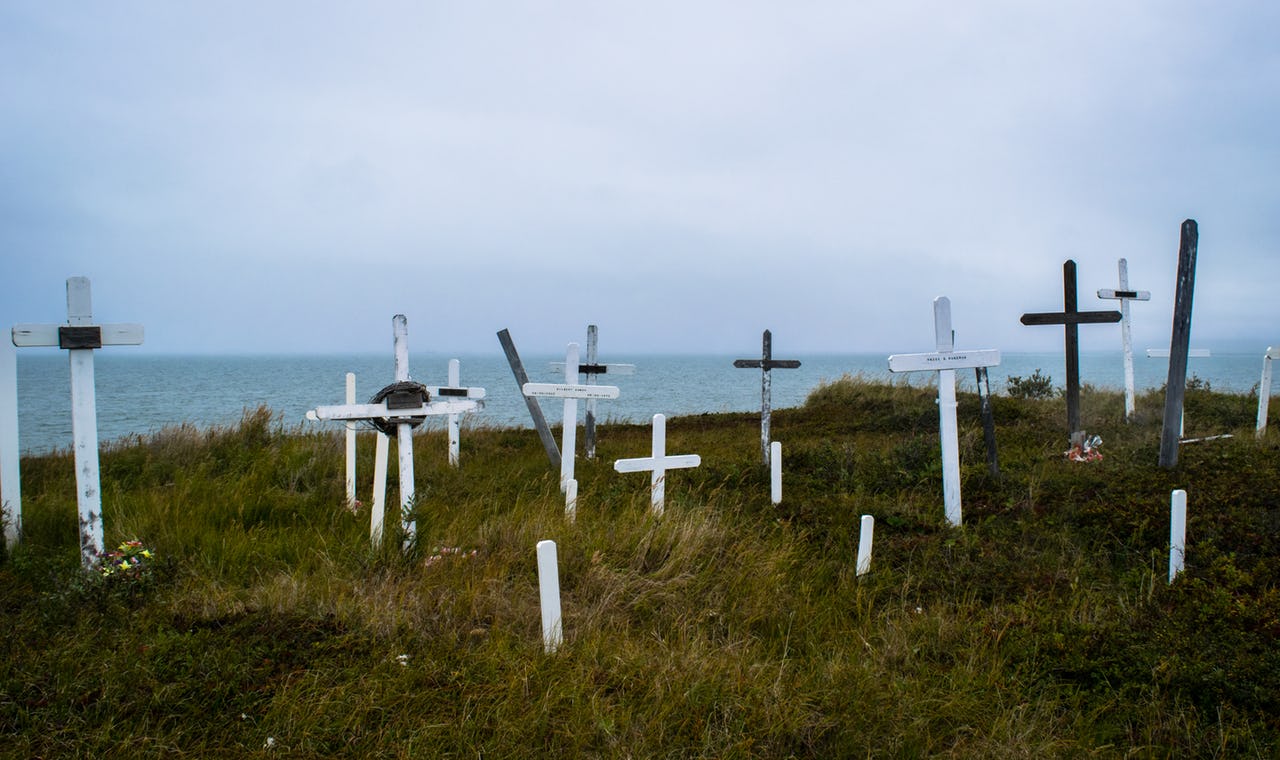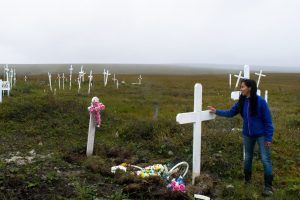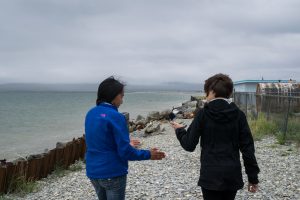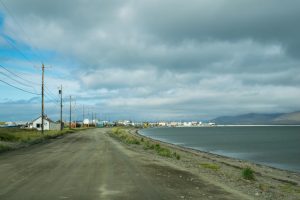When the Sea Wall Breaks: Climate Change in Teller, Alaska

The hill on which Teller’s cemetery sits has rapidly eroded, leaving many graves sitting just feet from the edge of a cliff above Port Clarence Bay. Photo: Eli Keene
As part of The Arctic Institute’s Summer Reading Series, we are reposting stories from Managing Director Victoria Herrmann’s National Geographic-funded project, America’s Eroding Edges.
The edges of our country are eroding, raising difficult questions about adaptation, relocation, and what it means to be an American experiencing climate change today. To connect the shared experiences of Americans facing these dramatic transformations, the National Trust for Historic Preservation has partnered with Victoria as she travels around the U.S. and its territories interviewing communities directly affected by shoreline erosion and climate change.
The Arctic Institute Summer Readings 2017
- A Continual State of Emergency: Climate Change and Native Lands in Northwest Alaska
- Self-Preservation: Amid Debate, An Alaskan Village Decides to Move Inland
- When the Sea Wall Breaks: Climate Change in Teller, Alaska
- Fighting the Rising Tide in Shaktoolik, Alaska
- Climate Change Hope in America
- A Delicate Balance of Commerce and Climate Change in Nome, Alaska
- Frontier of Change
There are three gravel roads that run out of Nome, each riddled with the ruins of Alaska’s gold rush.
To the east, the Nome-Council Highway passes the last rest stop of the Iditarod Dog Sled Race and snakes around a rusting train that’s slowly sinking into waterlogged permafrost. To the north, the Nome-Taylor Highway runs about 65 miles to Pilgrim Hot Springs. And to the west is Teller.
About a two-hour drive from Nome, (if you can resist stopping to watch the roaming musk oxen), Teller embodies the overlapping histories of Alaska Native communities, gold rush era fortune-seekers, the Bureau of Indian Affairs, and the pressures of rapid environmental change.
“There were thousands of gold miners here,” Blanche Okbaok-Garnie, Teller’s mayor, says of the gold boom days of the early 1900s. “Teller became Teller in 1900, and before that it was Libbyville,” she says, recounting the history of the village’s evolution from reindeer herding outpost to large gold mining community. Today, the village’s population has dwindled to about 280 Inupiat residents—the area’s original inhabitants—who continue the subsistence way of life that was central to the Teller area long before white settlers arrived in Alaska.
Teller’s history goes beyond the boom and bust of gold in Alaska, however. In the 1970s, Blanche tells us, Teller came under the BIA policy of forcing Alaska Native children to either attend school or be taken away from their parents. While Teller had a school, not every community in the area did. This meant that communities without schools were forced to disband, and co-locate with those that had them. This is how Teller became home not only to the community of Teller, but also the community of Mary’s Igloo, a village some 40 miles up the Kuzitrin River.
This partly explains the large group of 13 people, representing two different village governments, native corporations, and native government bodies, who have gathered in the community hall to meet us.
When it comes to climate change, Teller faces similar threats to those faced by other Alaska Native villages. Nathan Topkok, a member of the traditional council for Mary’s Igloo, starts the meeting by explaining how increasing air and water temperatures make fishing and snowmobile travel over tundra difficult and dangerous.
“Ice fishers go through the ice now, they can’t walk on it. Normally we can go fishing before Thanksgiving, but last year we couldn’t,” he says.
Another resident, Tanya Ablowalak, chimes in to say that it’s fall-time storms that pose the biggest challenge as they wash through the town’s corroded seawall. “Instead of every 20 years,” she describes, “we have a flood—we have high water warnings every single fall now.”
For Blanche, the most dramatic environmental change requires a short walk from the community center up a hill overlooking Port Clarence Bay, where the village cemetery sits. There, thawing permafrost is making the bluff more susceptible to erosion from wind and storm surges.

“My uncle is buried on the back side of the cemetery next to the sea,” she says, “and [his grave] was sticking out of the ground from erosion. So we were going to get permission from the court to dig him up and move him where he is less likely to just fall into the sea.”
The shifting of grave markers, many of which are now precariously close to the edge of the bluff, is unsettling. And it is indicative of the broader environmental challenges the community has been facing for years.
Over the past three decades, Teller has been forced to relocate both their airport and landfill four miles uphill to escape intense erosion along the village’s low-lying spit, a narrow strip of gravel jutting out from the center of town. Not only have these municipal services been displaced, but the village itself has been cleaved in two.
In 1974, an extreme flood forced the village to evacuate to higher ground two miles inland. They built emergency housing there, intended at the time to be temporary. But as flooding of the lower village became increasingly common, these temporary homes became permanent. The Coyote Creek Subdivision, locally known as the New Site, is now home to 33 permanent homes, all of which remain without sewer service today.
The flooding and erosion that stretched Teller out has had other environmental consequences as well. The landfill that was once at the base of the village now sits uphill from it.
“It was only designed to last ten years and it’s overfilled now,” Blanche says. Now, when it rains, she tells us, “it drains into our only drinking water . . . It should have never been built on top of the hill and draining down on the berries that we eat. The greens that we eat, the only clean fresh water source is right there.”
When asked if there has been any effort to mitigate these issues, she responds, “Only studies.”
The lack of real federal or state action to address a growing number of environmental challenges in Teller is unsurprising. Building costs in Alaska dwarf anything seen in the Lower 48, and with 31 Alaska Native villages currently at imminent risk from erosion, resources are scarce.
Teller, like other communities in Alaska, is attempting to protect against the increasingly frequent flooding. Today, a small, rusted sea wall is all that separates the town from the water.
“Years ago, they threw a bunch of stuff down here, whatever they had, trucks and the equipment to help break some of the waves,” Blanche explains as she points down to rusted out machinery.

Walking along the sea wall, you can see three generations of defense. Furthest out is the first community-led effort of armoring the coast with whatever heavy machinery they could find. About ten years later, residents again created their own defense through a wall of old oil drums filled with gravel. Both the first and second generation of seawall are now corroded and washing out. Dotted among the rusted metal, wood beams and wire caging also provide a stronger, but sporadic barrier.
In 2011, a storm washed out a central portion of the wall, allowing water to flood into the community. Blanche explains, “Water rushes in every year and goes into the roads and into the sewage lagoon up here.”
Teller is in a precarious position. Though it faces a number of imminent threats, it is not among the four villages in Alaska that have been identified as requiring immediate relocation. This means that many of the problems the village faces, it faces off the radar, on its own.
The best strategy, at least for patching the sea wall, may be for residents to once again band together as they did in the 1970s. But the splitting of the community has made full community cooperation a challenge. And without sufficient resources or outside support to implement new infrastructure projects, there is little to galvanize support for such action.
“Usually we don’t talk openly,” Blanche observes after the meeting. “We don’t share stories like we did today. People were so willing to talk to you, but they won’t talk to each other.”
The commentary was originally published on March 20, 2017.
